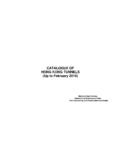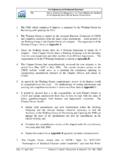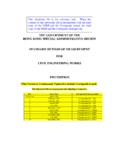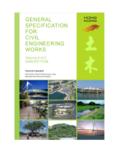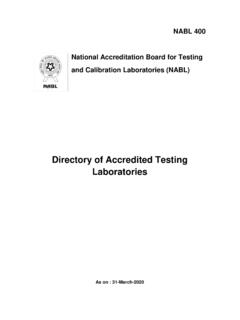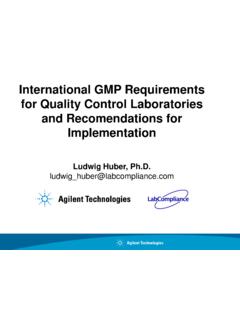Transcription of Model Specification for Soil Testing - CEDD
1 Geospec 3 Model Specification for Soil Testing Geotechnical Engineering Office Civil Engineering and Development Department The Government of the Hong Kong Special Administrative Region Geospec 3 Model Specification for Soil Testing Geotechnical Engineering Office Civil Engineering and Development Department The Government Of the Hong Kong Special Administrative Region 2 The Government of the Hong Kong Special Administrative Region First published, November 2001 Continuously updated e-version, 29 August 2017 Prepared by: Geotechnical Engineering Office, Civil Engineering and Development Department, Civil Engineering Building, 101 Princess Margaret Road, Homantin, Kowloon, Hong Kong. This Geospec is a continuously updated version incorporating amendments issued since the Geospec was published. The continuously updated version is released in e-format only on the CEDD website. This Geospec is to be cited as GEO (2017).
2 Model Specification for Soil Testing (Geospec 3) (Continuously Updated E-Version released on 29 August 2017). Geotechnical Engineering Office, Civil Engineering and Development Department, HKSAR Government, 324 p. 3 Foreword This Geospec presents the recommended standard methods for Testing of soils in Hong Kong for civil engineering purposes. Since 1992, the Geotechnical Engineering Office (GEO) has carried out a two-phase review of the soil Testing methods with the aim to produce standard methods for Testing of soils in Hong Kong for civil engineering purposes. The first phase of the review covered the soil classification and compaction tests (the Phase I tests) and was published in GEO Report No. 36 in 1994. The second phase of the review covered the soil shear strength and compressibility tests (the Phase II Tests), as well as additional tests akin to the Phase I tests.
3 The review has now been completed. The recommended standard methods for all Phase I and Phase II tests are included in this Geospec, which supersedes GEO Report No. 36. This Geospec is divided into three parts. Part I gives general and technical guidance on planning and supervising laboratory tests, to ensure that quality test results are obtained. Part II and Part III provide detailed technical procedures for individual tests. The technical standards presented in this Geospec are mainly based on BS 1377 (BSI, 1990). With the permission of the British Standards Institute, extracts from BS 1377 (BSI, 1990) and other British Standards have been incorporated into this Geospec. To ensure that this Geospec would be considered as a consensus document in Hong Kong, a draft version of this Geospec was widely circulated to interested parties and experts both locally and overseas. Many useful comments were received, and they have been taken into account in finalising the Geospec.
4 All contributions are gratefully acknowledged. This document was prepared largely by Ir Philip W K Chung, Ir Dr Richard P L Pang and Ir C K Cheung. Editing of the document was assisted by Ir B N Leung and Dr L S Cheung in the early stage, and was later taken over by Ir Jenny F Yeung and Ir M Y Ho. Ir Y C Chan provided general supervision during the final stage of the document preparation. Practitioners are encouraged to comment at any time to the GEO on the contents of this Geospec, so that improvements can be made to future editions. Chan Head, Geotechnical Engineering Office 4 Contents Page No. Title Page 1 Foreword 3 Contents 4 List of Tables 9 List of Figures 10 Part I 13 1 Introduction 14 Background 14 Definitions and Terminology 14 2 General Guidance to Specifiers 16 General 16 Planning for Testing during Ground Investigation 16 Selection of laboratories 17 Specifying Test Requirements 18 Selection of Samples and Minimum Sample Mass 20 Handling of Samples 22 Supervision of Testing 22 3 Technical Guidance to Specifiers 24 General 24 Determination of Moisture Content 24 Determination of Atterberg Limits 25 Determination of Particle Density 25 Determination of Particle Size Distribution 26 Determination of Amount of Chemical Substances and 27 Electro-chemical Properties Determination of Dry Density/Moisture Content Relationship 28 Determination of In-situ Bulk Density, In-situ Dry Density 29 and Relative Compaction 5 Page No.
5 Determination of California Bearing Ratio 30 Determination of Compressibility Characteristics 31 Determination of Shear Strength Using a Triaxial Apparatus 35 Determination of Shear Strength Using a Shear Box 40 Apparatus Part II 42 4 General Procedures for Sample Preparation for Phase I Tests 43 General 43 Assessment Sieving 43 Moisture Content Determination 44 Drying of Samples 44 Mechanical Processing 44 5 Determination of Moisture Content 46 Determination of Moisture Content by Oven-drying 46 at 45 5 C Determination of Moisture Content by Oven-drying 50 at 105 5 C Comparative Test for the Determination of Moisture Content 51 by Oven-drying 6 Determination of Atterberg Limits 53 Determination of Liquid Limit, Plastic Limit and Plasticity 53 Index Determination of Liquidity Index 63 7 Determination of Particle Density 64 Determination of Particle Density by Gas Jar Method 64 Determination of Particle Density by Small Pyknometer 67 Method 8 Determination of Particle Size Distribution 71 Determination of Particle Size Distribution by Wet Sieving 71 (with Dispersant) 6 Page No.
6 Determination of Particle Size Distribution by Wet Sieving 82 (without Dispersant) Determination of Particle Size Distribution by the Pipette 83 Method (with Dispersant) Determination of Particle Size Distribution by the Pipette 93 Method (without Dispersant) Determination of Particle Size Distribution by the Hydrometer 95 Method (with Dispersant) Determination of Particle Size Distribution by the Hydrometer 106 Method (without Dispersant) Construction of a Continuous Particle Size Distribution Curve 107 from the Results of Wet Sieving and Sedimentation Tests 9 Determination of Amount of Chemical Substances and 109 Electro-chemical Properties Determination of Organic Matter Content 109 Determination of the Mass Loss on Ignition 117 Determination of Total Sulphate Content of Soils and Sulphate 120 Content of Groundwater and of Aqueous Soil Extracts by Gravimetric Method Determination of Water-soluble Chloride Content 129 Determination of the pH Value 135 10 Determination of Dry Density/Moisture Content Relationship 138 Determination of Dry Density/Moisture Content Relationship 138 of Soils Containing Particles Which Are Not Susceptible to Crushing (Using 1000 cc Mould and kg Rammer)
7 Determination of Dry Density/Moisture Content Relationship 149 of Soils Containing Particles Which Are Susceptible to Crushing (Using 1000 cc Mould and kg Rammer) Determination of Dry Density/Moisture Content Relationship 151 of Soils Containing Particles Which Are Not Susceptible to Crushing (Using CBR Mould and kg Rammer) Determination of Dry Density/Moisture Content Relationship 155 of Soils Containing Particles Which Are Susceptible to Crushing (Using CBR Mould and kg Rammer) 7 Page No. Determination of Dry Density/Moisture Content Relationship 157 of Soils Containing Particles Which Are Not Susceptible to Crushing (Using 1000 cc Mould and kg Rammer) Determination of Dry Density/Moisture Content Relationship 159 of Soils Containing Particles Which Are Susceptible to Crushing (Using 1000 cc Mould and kg Rammer) Determination of Dry Density/Moisture Content Relationship 160 of Soils Containing Particles Which Are Not Susceptible to Crushing (Using CBR Mould and kg Rammer) Determination of Dry Density/Moisture Content Relationship 161 of Soils Containing Particles Which Are Susceptible to Crushing (Using CBR Mould and kg Rammer)
8 11 Determination of In-situ Bulk Density, In-situ Dry Density and 162 Relative Compaction Determination of In-situ Bulk Density and In-situ Dry Density 162 of Soils by Sand Replacement Method Suitable for Fine- and Medium-grained Soils (with Small Pouring Cylinder) Determination of In-situ Bulk Density and In-situ Dry Density 172 of Soils by Sand Replacement Method Suitable for Fine-, Medium- and Coarse-grained Soils (with Large Pouring Cylinder) Determination of In-situ Bulk Density and In-situ Dry Density 177 of Soils by Nuclear Densometer Method Suitable for Fine- and Medium-grained Soils Determination of Relative Compaction of Fill Material 181 12 Determination of the California Bearing Ratio 183 Determination of the California Bearing 183 Ratio (CBR) Part III 202 13 General Procedures for Sample Preparation for Phase II Tests 203 General 203 Preparation of Remoulded Test Specimens from Disturbed 205 Soil Samples Preparation of Test Specimens from Undisturbed Soil 208 Samples 8 Page No.
9 14 Determination of Compressibility Characteristics of Soils 215 The One-dimensional Consolidation Test 215 The Isotropic Compression Test in a Triaxial Cell 231 15 Determination of Shear Strength of Soils Using Triaxial Apparatus 243 The Unconsolidated Undrained Triaxial Compression Test 243 without Pore Pressure Measurement The Isotropically Consolidated Undrained Triaxial 250 Compression Test with Pore Pressure Measurement The Isotropically Consolidated Drained Triaxial 278 Compression Test with Measurement of Volume Change 16 Determination of Shear Strength of Soils Using Shear Box Apparatus 284 The Direct Shear Test (Small Shear Box Apparatus) 284 The Direct Shear Test (Large Shear Box Apparatus) 298 References 305 Appendices 307 Appendix A: Calibration Requirements for Reference Standards, 308 Test Equipment and Materials Appendix B: General Information to be Included in Test Reports 315 Glossary of Terms 318 9 List of Tables Table No.
10 Page No. Minimum Mass of a Disturbed Soil Sample Required for Each Phase I Soil Test 21 Number of Tests for Determining the Relative Compaction of Fill Materials 30 Initial Pressure for One-dimensional Consolidation Test 33 Maximum Allowable Mass of Materials Retained on Each Test Sieve in Wet Sieving 57 Minimum Mass of Soil Specimen for Sieving 73 Pipette Sampling Times and Equivalent Particle Diameters 90 Viscosity of Water 92 Summary of Sample Preparation Methods 142 Standard Force-penetration Relationships for 100% CBR 200 Mass of Soil Required for Each Test Specimen from Disturbed Samples 206 Maximum Size of Particles Allowed in Test Specimens for Phase II Tests 206 Factors for Calculating cv and Time to Failure 241 Corrections for Vertical Side Drains 273 10 List of Figures Figure No. Page No. Details of Cone for the Liquid Limit Test 55 Procedure for Wet Sieving - Method A 74 Procedure for Wet Sieving - Method B 77 Sampling Pipette for the Sedimentation Test 84 Arrangement for Lowering Sampling Pipette into Soil Suspension 86 Hydrometer for the Determination of Fine Particle Size 97 Essential Measurements for Calibration of Hydrometer 100 Mould for the Compaction Test (1L Mould)


